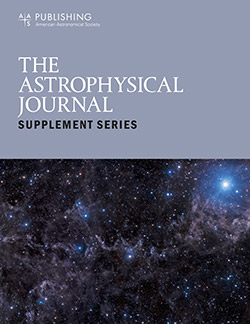在Athena++代码中实现化学
IF 8.5
1区 物理与天体物理
Q1 ASTRONOMY & ASTROPHYSICS
引用次数: 0
摘要
化学在天体物理流体的许多方面起着关键作用。原子和分子是加热和冷却的媒介,决定电离分数,充当观察示踪剂,并建立生命的分子基础。我们在公开可用的磁流体力学代码Athena++中实现了一个化学模块。我们实现了几个适合模拟星际介质(ISM)的化学网络和加热和冷却过程。还包括KIDA格式的一般化学网络框架,允许用户轻松实现自己的化学。辐射传递和宇宙射线电离与化学耦合,用简单的六射线近似求解。化学和热过程演变为一个耦合的常微分方程系统与隐式求解器从CVODE库。我们执行并提出了一系列测试,以确保代码的数值精度和收敛性。许多测试将化学与气体动力学结合起来,包括与解析解的比较,光解区域和冲击的一维问题,以及湍流ISM的真实三维模拟。我们将代码与Athena++的新公开版本一起发布,旨在为天体化学模拟社区提供健壮而灵活的代码。本文章由计算机程序翻译,如有差异,请以英文原文为准。
Implementation of Chemistry in the Athena++ Code
Abstract Chemistry plays a key role in many aspects of astrophysical fluids. Atoms and molecules are agents for heating and cooling, determine the ionization fraction, serve as observational tracers, and build the molecular foundation of life. We present the implementation of a chemistry module in the publicly available magnetohydrodynamic code Athena++ . We implement several chemical networks and heating and cooling processes suitable for simulating the interstellar medium (ISM). A general chemical network framework in the KIDA format is also included, allowing users to easily implement their own chemistry. Radiation transfer and cosmic-ray ionization are coupled with chemistry and solved with the simple six-ray approximation. The chemical and thermal processes are evolved as a system of coupled ordinary differential equations with an implicit solver from the CVODE library. We perform and present a series of tests to ensure the numerical accuracy and convergence of the code. Many tests combine chemistry with gas dynamics, including comparisons with analytic solutions, 1D problems of the photodissociation regions and shocks, and realistic 3D simulations of the turbulent ISM. We release the code with the new public version of Athena++ , aiming to provide a robust and flexible code for the astrochemical simulation community.
求助全文
通过发布文献求助,成功后即可免费获取论文全文。
去求助
来源期刊

Astrophysical Journal Supplement Series
地学天文-天文与天体物理
CiteScore
14.50
自引率
5.70%
发文量
264
审稿时长
2 months
期刊介绍:
The Astrophysical Journal Supplement (ApJS) serves as an open-access journal that publishes significant articles featuring extensive data or calculations in the field of astrophysics. It also facilitates Special Issues, presenting thematically related papers simultaneously in a single volume.
 求助内容:
求助内容: 应助结果提醒方式:
应助结果提醒方式:


